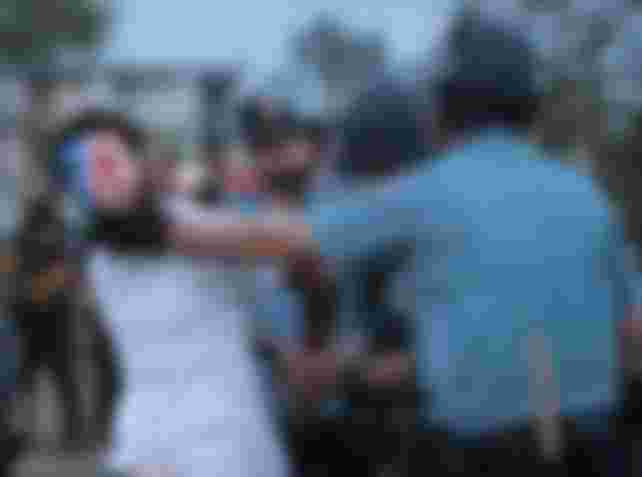Black lives matter

8 Minutes and 46 Seconds: How George Floyd Was Killed in Police Custody
The Times has reconstructed the death of George Floyd on May 25. Security footage, witness videos and official documents show how a series of actions by officers turned fatal.
These times has reconstructed the death of George Floyd on May 25. Security footage, witness videos and official documents show how a series of actions by officers turned fatal.
On May 25, officers arrested a 46-year-old black man, after a convenience store employee called 911 and told the police that Mr. Floyd had bought cigarettes with a counterfeit $20 bill. Seventeen minutes after the first squad car arrived at the scene, Mr. Floyd was unconscious and pinned beneath three police officers, showing no signs of life.
GEORGE FLOYD
By combining videos from bystanders and security cameras, reviewing official documents and consulting experts, The New York Times reconstructed in detail the minutes leading to Mr. Floyd’s death. Our video shows officers taking a series of actions that violated the policies of the Minneapolis Police Department and turned fatal, leaving Mr. Floyd unable to breathe, even as he and onlookers called out for help.
The day after Mr. Floyd’s death, the Police Department fired all four of the officers involved in the episode. On May 29, the Hennepin County attorney, Mike Freeman, announced third-degree murder and second degree charges against Derek chauvin the officer seen most clearly in witness videos pinning Mr. Floyd to the ground. Mr. Chauvin, who is white, kept his knee on Mr. Floyd’s neck for eight minutes and 46 seconds, according to the criminal complaint against him. Our video shows that Mr. Chauvin did not remove his knee even after Mr. Floyd lost consciousness, and for a full minute after paramedics arrived at the scene.
On June 3, Hennepin County prosecutors added a more serious second-degree murder charge against Mr. Chauvin and also charged each of the three other former officers — Thomas Lane, J. Alexander Kueng and Tou Thao — with aiding and abetting second-degree murder.
Dealing with the Aftermath of George Floyd’s Death
George. Floyd’s death sent shockwaves around the country, and around the world, in a way not seen since Watts, Bloody Sunday, Detroit, the University of Mississippi, and other violent civil rights protests in the 1960s.
Understanding the Anger
Other recent controversial slayings, such as Michael Brown in Missouri in 2014, Philando Castile in Minnesota in 2016, Eric Garner in New York in 2014 and several others produced considerable anger. Each of these deaths involved a police officer using prolonged excessive force.
Coronavirus lockdowns, while necessary, affected minorities. The additional hardships of unemployment and homelessness caused by the pandemic have also led to increased frustrations in most communities.
The criminal justice system still unevenly affects minorities. Nationally, black inmates constitute about a third of prison inmates, yet they make up about a tenth of the population. Closer to home, the NYPD has recently arrested forty individuals for violating COVID-19 social distancing requirements. Thirty-five of those arrested were black.
The disproportionate nature of this affliction against minorities is disturbing and a meaningful remedy is necessary.
The Current and Future Role of Police Officers
Floyd’s death served as another example of the systematic use of excessive force on minorities that has been the standard operating procedure in our country. Our legal system has continually upheld this use of excessive force, which has played a major role in creating the current combative atmosphere between minorities and police officers.
Floyd’s death stirred many different reactions. For some, it opened their eyes to how little progress our country has made over the years. For others it was yet another injustice that served as a call to action.
Police officer approval ratings were already below 50 percent, and Floyd’s murder accelerated this downward trend. Additionally, almost 80% of Americans said the anger over Floyd’s death was either fully justified or partially justified.Given the current situation, what will police forces of the future look like? And what should they look like?
In confrontational situations it is important to appreciate opposing concerns. Police officers now believe they have targets on their backs, stemming from the backlash of the arrest of the officers charged in George Floyd’s death. At the same time there is widespread concern from community members across the nation that police brutality of this nature will recur and, in non-publicized cases, will continue to go unpunished. The truth of the matter is that this is not a minority issue or a nonwhite issue, but it is a human issue. “Injustice anywhere is a threat to justice everywhere” as famously quoted by Martin Luther King Jr., and this still resounds true today. “Whatever affects one directly, affects all indirectly”.
After George Floyd’s Death, Toll Rises in Protests Across the Country

At least five people have died in unrest over the death of Mr. Floyd. Injuries have been numerous, and millions of dollars in damage to property has occurred.
Scores of American cities were on edge on Monday night as protesters faced off with the police for a seventh straight night since the death of George Floyd at the hands of the Minneapolis police. Curfews were ordered in New York City and throughout the country in an effort to stem the toll of deaths, injuries and vandalism that have accompanied demonstrations that grew violent.
The clashes have echoed in the streets of at least 140 cities, and at least five people had died as the country entered another long night. An untold number more, including protesters and police officers, have been injured. Thousands of people have been arrested and fires, looting and vandalism have caused millions of dollars in damage to buildings and businesses.
Amid demonstrations from the beach communities of California to the park right outside the White House, President Trump warned on Monday that he would order the military into American cities if officials could not get their streets under control. “We will end it now,” he said.
PROTESTS IN CALIFORNIA
“Mayors and governors must establish an overwhelming presence until the violence is quelled,” the president said in a short address from the Rose Garden. “If a city or state refuses to take the actions necessary to defend the life and property of their residents, then I will deploy the United States military and quickly solve the problem for them.”
Before striding outside the White House gates, where the streets had been cleared by the authorities, Mr. Trump declared, “I want the organizers of this terror to be on notice that you will face severe criminal penalties and lengthy sentences in jail.”
That marches in response to Mr. Floyd’s violent death have themselves ended in injury and death was a contradiction deeply felt by those close to people who have died. “She would not have wanted this act of violence to instigate more violence,” Amy Lynn Hale said of her niece, Italia Kelly, 22, who was shot in her car in a Walmart parking lot in Davenport, Iowa, as she left a demonstration late Sunday night.
The growing toll came as a curfew was starting at New York City — only the latest of dozens of cities, including Los Angeles, Chicago and Minneapolis, to order people to stay home as clashes have escalated. Nearly 20,000 members of the National Guard have been called up in 23 states.
In Minneapolis on Monday, Mr. Floyd’s brother Terrence made an emotional visit to the site where Mr. Floyd was detained, at one point kneeling silently at a memorial of flowers and signs. Terrence Floyd expressed concern about the destruction that had unfolded because, he said, “that’s not going to bring my brother back at all.”
Two autopies were released on Monday, one by a government agency and one by doctors working with the Floyd family. The autopsies concurred that George Floyd’s death was a homicide, but differed over the specific causes and contributing factors.
In Washington, where windows of prominent buildings have been smashed, cars overturned and fires set, Attorney General William P. Barr expanded the response, increasing federal law enforcement in the city and directing the Bureau of Prisons to send in Special Operation Response Teams.
Terrence Floyd, the brother of George Floyd, visited the site of his death in police custody in Minneapolis, on Monday. human toll of what has come after Mr. Floyd’s death is difficult and imprecise because protests have emerged in so many places. Much is still unfolding or unknown. At least five deaths have occurred amid unrest, while other deaths have taken place nearby but their ties to protests are uncertain.
In Louisville, David McAtee, 53, the owner of a well-known barbecue business, was shot and killed early Monday. The authorities said that officers from the Louisville Metro Police Department and National Guard soldiers opened fire in response to a gunshot as they tried to disperse a large crowd after a curfew had gone into effect. It was not immediately clear if Mr. McAtee had been killed by the police or someone in the crowd, the authorities said.
Outside a federal building in Oakland, Calif., a security officer was killed on Friday night. Chad Wolf, the acting secretary of the Department of Homeland Security, connected the shooting to the protests around the country, describing “an outright assault on our law enforcement community.” But other officials, including Gov. Gavin Newsom of California, suggested that links to the protests were less clear, saying that a motive in the death was not known.
A reporter was hit in the eyesby a rubber bullet. A police officer experienced a skull fracture Protesters have been hit by cars and people guarding businesses have been beaten. An untold number of people have been sent to hospitals with broken bones or more serious injuries. Experts say that the possibility looms of a spike in coronavirus cases after days of gathering in large numbers.
Major chain stores, mom-and-pop groceries, statehouses and police precincts have sustained damage. Police cars have been burned across the country. Mayors of multiple cities have cited damage in the millions of dollars, a prospect ever more alarming given the economic straits cities were already facing amid Covid-19.
In Louisville, people on Monday were mourning the death of Mr. McAtee, who sold barbecue in the West Louisville neighborhood where he was killed. “Everybody in West Louisville bought barbecue from this man — everyone knows him,” said Denise Bentley, a former longtime City Council member. “There are very few people in West Louisville who didn’t know him.”
Flowers and a package of beef tenderloin were left as a memorial for David McAtee at the feet of officers of the Louisville Police Department on Monday. McAtee, the owner of a local BBQ restaurant, was killed in an officer-involved shooting. On the street where Mr. McAtee was killed, protesters gathered Monday to lament his death.




This good a wonderful and well detailed right up... I wrote an article on this too when it first took place and I am happy to see how many people responded to this event ... Which shows how much love still exists in the world for each other as humans